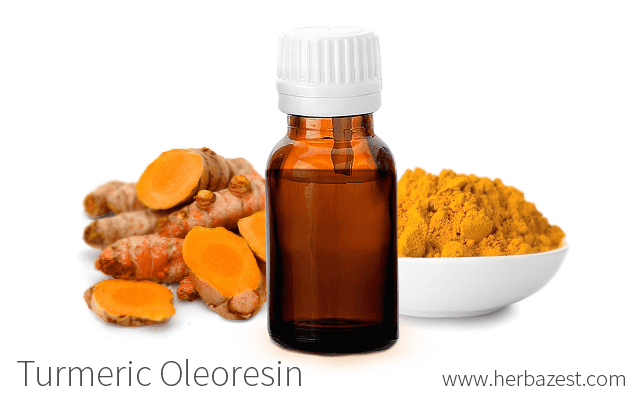Turmeric oleoresin is an organic fat and alcohol-soluble extract of turmeric that contains curcuminoids as well as volatile and fixed oils. Typically used as a spice and coloring agent in food, turmeric oleoresin is obtained through the extraction of ground turmeric with organic solvents. Though content ratios vary by cultivar and method of extraction, a good turmeric oleoresin typically contains 30 - 40% curcuminoids, 15 - 20% volatile oil, and 20 - 30% fixed oils.
How to Make Turmeric Oleoresin
Turmeric oleoresin contains highly concentrated amounts of turmeric's active ingredients and, while comparable to some other simple extractions, turmeric oleoresin is best prepared in a lab setting where it generates a yield of 8 - 12%, depending on the solvents and methods of extraction.
Often producing an extract with more vibrant aromas than the herb's original constituents, supercritical CO2 extraction - a relatively new technique - is the preferred method of obtaining turmeric oleoresin. However, with proper distilling equipment, a similar preparation can be made in the home.
Supplies and ingredients include:
- Five cups of ground turmeric
- If a distillation kit is not available, fashion one using a pressure cooker, plastic tubing, metal pipes, and several water basins.
- In the final step, a separating funnel is the most efficient way of removing the essential oil from the liquid.
Step-by-step process:
- Set up the distillation kit in a clear, well-ventilated work area.
- Add turmeric to the boiling flask, establishing a temperature range of 115 - 130°F (45 - 55C).
- Vapors traveling up the still head will pass through the condenser. If using a homemade still, make sure the metal tubing passes through ice-cold water to mimic the effect of condensation.
- After condensation, the vapors will return to their liquid form, dripping into the collection flask. This can take as much as six or more hours.
- The collection flask contains both liquid and essential oil extract of turmeric, which will be visibly floating near the surface. Transfer the mixture to a separating funnel to isolate the resulting turmeric extract.
- Using a dark-colored glass bottle, store the oil in a cool area.
Benefits of Turmeric Oleoresin
While often used for flavoring and coloring foods, turmeric oleoresin possesses a myriad of therapeutic properties. Its curcuminoids are the primary compounds responsible for its medicinal action.
BESIDES BEING MORE COST EFFECTIVE THAN GROUND TURMERIC, OLEORESIN IS ALSO FREE FROM CONTAMINATION AND HAS A LONG SHELF LIFE OF UP TO THREE YEARS.
Turmeric oleoresin stabilizes blood glucose and cholesterol levels in the body, helping to prevent weight gain.1 It also reduces inflammation for an overall pain-relieving effect that has been useful in the treatment of arthritis, gallstones, ulcers, and irritable bowel syndrome.2 It encourages bile excretion and helps the liver to remove toxins. In addition to this, curcumin found in turmeric oleoresin has been shown to reduce toxicity caused by lead, copper, arsenic, and other heavy metals.3
Although it is common to ingest turmeric oleoresin to reap its medicinal benefits, it can also be used as part of cosmetic preparations for youthful, radiant skin. Its antioxidant action protects the cells from damage and also promotes faster wound healing.
In addition to the above-mentioned benefits, turmeric oleoresin is also being studied for its potential to improve cognitive function and prevent age-related neurodegenerative diseases, like Alzheimer's and dementia.4
Turmeric oleoresin is a powerful superextract containing high concentrations of turmeric's active ingredients. More effective than curcuminoids and essential oil alone, the health benefits of turmeric oleoresin are backed by several recent studies, earning it a place among the best herbal supplements for health.
Sources
- Chemistry of Spices, pp. 99-100
- CNS Neuroscience & Therapeutics, Curcumin and Alzheimer’s Disease, 2010
- Food Colorants: Chemical and Functional Properties, pp. 329-332
- The Agronomy and Economy of Turmeric and Ginger, pp. 47-60
- Turmeric: The genus Curcuma, pp. 227-234
- Wound Repair and Regeneration, Enhancement of wound healing by curcumin in animals, 1998
- FAOSTAT, Turmeric Oleoresin
Footnotes:
- Journal of Agricultural and Food Chemistry. (2016). Effets of ingested turmeric oleoresin on glucose and lipid metabolisms in obese diabetic mice: a DNA microarray study. Retrieved November 22, 2021, from: https://pubs.acs.org/doi/10.1021/jf061788t
- Journal of Clinical Medicine. (2018). A Meta-Analysis of the Clinical Use of Curcumin for Irritable Bowel Syndrome (IBS). Retrieved November 22, 2021, from: https://www.ncbi.nlm.nih.gov/pmc/articles/PMC6210149/
- Food and Chemical Toxicology. (2014). Protective effect of curcumin against heavy metals-induced liver damage. Retrieved November 22, 2021, from: https://pubmed.ncbi.nlm.nih.gov/24751969/
- Journal of Clinical Psychopharmacology. (2008). Six-month randomized, placebo-controlled, double-blind, pilot clinical trial of curcumin in patients with Alzheimer disease. Retrieved November 22, 2021, from: https://pubmed.ncbi.nlm.nih.gov/18204357/




